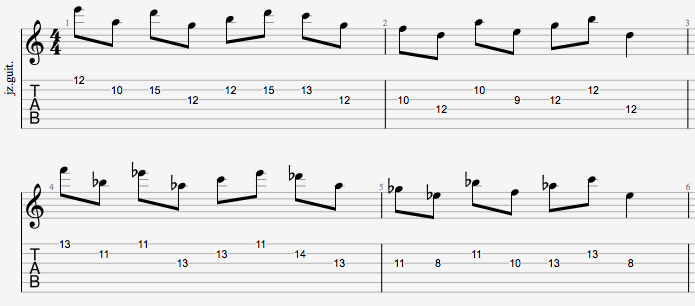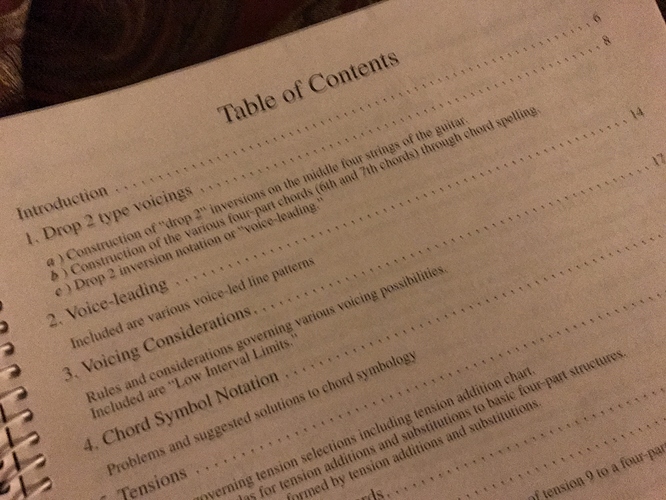Continuing the discussion from The Frank Gambale interview is here!:
I’ve my FordScales (a play on “chord-scales” using my last name) systems that helped me to organize my thinking about the fretboard. The original FordScales stuff lives within the 3nps concept, but in fact is not positional, and more about organizing the intervals within a given space. The two patterns may connect to form the six string, three note per string patterns, but they don’t have to connect that way. They anchor relative to chord tones, but they don’t reference any chord shape. We don’t usually associate the 3nps stuff with anything “CAGED-y,” so no surprise there…
“FordScales,” Open and Closed Patterns
4 5 6
1 2 3
5 6 7
and
2 3 4
6 7 1
3 4 5
7 1 2
The later system that answered my original observation is a six note per string chromatic approach using the note A (for a variety of reasons) as an anchor point. This affords me a pianistic view of the fretboard where the melodic patterns lay within the physical structure, but everything is within that structure, the chord tones, the scales… (It’s what I later learned Barry Harris would refer to as the “God” scale.)
“FordScales Chromatic Approach”
Eb E F Gb G Ab
A Bb B C Db D
Eb E F Gb G Ab
A Bb B C Db D
Eb E F Gb G Ab
A Bb B C Db D
When actually playing, not practicing or working out the fingering to a tune, I’m not restricted to this framework. Having practiced all of the scales in all of the possible keys, within the system, I’ve covered most of the physical shapes, and the dominant thought process is linear melodic structure, not physical structure. I’m playing dozens of physical patterns within each two-string cell, but it doesn’t guide my primary thought process, merely adding granularity to the different keys akin to the benefit of black and white keys on a piano.
So these systems, in addition to the Berklee scale patterns, Bobby Ferrazza scales, Segovia scales, single string playing, pentatonic boxes, and my classical guitar roots in position playing, all inform my improvisation and general sense of fretboard organization.
…excerpted from the Frank Gambale interview discussion thread.
@Brendan or @Troy, does this belong under playing technique? Not sure. Thanks.
I do think it’s a broader discussion than just the “playing technique,” so I’m defaulting to harmony and theory.
It first came up on the Fretboard Visualization Methods thread…
Both of the systems I’ve illustrated here depend on getting one’s mind around the third between the G and the B string on the standard tuned guitar. Others like Tom Quayle have worked around the issue by tuning strictly in fourths. I didn’t want to tune in fourths and miss out on traditional guitar-isms, and in my own teaching, I refer to the “warp refraction” principle borrowed from John Finn (the wiki article seems to suggest that’s who coined it) that I picked up on reading Guitar Player or Guitar for the Practicing Musician. I don’t recall offhand.
I shared an example “mapping” of a transposed phrase, here…
Here’s the image, corresponding to @JakeEstner’s example phrase from the thread over Dm, and transposed to Ebm…
And here is a transcription of the head of Charlie Parker’s Confirmation by a friend, Mike Titlebaum, taken from YouTube, arranged in the FordScales chromatic approach that I put together in Guitar Pro 7.5 over the weekend for myself and another forum member who inquired about it’s applicability to Omnibook stuff.
Confirmation by Charlie Parker, transcribed Mike Titlebaum, arranged for FordScales, by Daniel Ford
It’s fresh off the presses, so please let me know if anyone finds any errors. Haven’t actually proofed it myself yet.
Here’s the original transcription by Mike Titlebaum on YouTube…
When working with Charlie Parker Omnibook type transcriptions and other charts, the FordScales Chromatic Approach allows me to completely skip the issue of where to play the notes and to focus on the more familiar CtC speed picking issues, and all the playing through changes issues that most improvising musicians must come to terms with.
The chromatic pattern drapes across all parts of the neck, so if a guitarist wants to play it an octave lower, taking into consideration the Finn “warp refraction principle,” the patterns stay exactly the same.
Having come up playing Berklee patterns, there was a point where I realized that I was going to need to be able to deal with everything, in all keys, times five, or to find something simple and more manageable.
If anyone has any questions any of this, feel free to hit me up here. In the meantime, back to playing music.
I really enjoyed the way you described the “FordScales” system.
When I learnt about the Gregorian modes, harmonic fields and the foundation stone of learning music theory I got it by a system that pretty much is equal to yours.
The way things got organized, and how it kinda connect with it other forming a continuous thing.
Pretty awesome! BTW the guitar pro file you uploaded is not working, at least I couldn’t make it work, I’m using Guitar Pro 6.
The example you posted, the one to JakeEstner just came out of your mind or is something rearranged?
Hey, thanks GCAN! And bummer about the RSI. I deal with my own, and it’s not fun.
Which did you find familiar, the open and closed diatonic patterns or the chromatic approach? How did your approach help you?
I’m not sure where @JakeEstner got the phrase. I just arranged it differently. 
Yeah RSI really sucks! I changed the approach to guitar completely because of it, nowadays I just try to rest more and keep hitting the gym, it helps a lot. Hope yours are under control
The open and closed patterns, that’s how I learnt the diatonic scale and the harmonic fields that follows… The chromatic approach sounded a AWESOME thing to work on, it probably will help in developing the use of chromaticism more often! Thanks a lot about it I will give it a try!
Any way this kind of visualization, at least to me, is more “organic”. Cause you can connect more easily the fretboard, and get a better feel about chords in different positions and using various strings. Those CAGEDs were natural at some point when I was improvising, cause sometimes I wanted to use a few patterns and to connect them “better” I started doing things like those CAGED shapes.
Kudos for the arranged phrase! 
Well thank you, @GCAN! Such kind words!
With regard to injury, thankfully I’m rather comfortable when playing music or typing. It’s using scroll wheels on mice, texting, and such that break the ergonomics and hurt me when under stress at my day job. The world is getting kind of ridiculous in terms of day to day UX. Lot of devolution in design. But I’m not bitter. 
GP 7.5 is a huge advance over GP 6 and comprises features that are used regularly in my charts. I recommend upgrading. The iOS version has caught up version-wise recently too.
I never related the FordScales open and closed patterns to open-position chords. I was living in a world of enharmonic voicings and drop-2’s at that time. Studying jazz with pianist/mentor/friend Eric Gunnison back then, I was fascinated with drop two voicings a la Bret Willmott’s Complete Book of Harmony Theory and Voicing, and the relationship of common guitar jazz voicings to what folks like Holdsworth were doing. But that shouldn’t stop others from referencing what works for them! “Organic” yes, and free-range. 
Glad you find the FordScales Chromatic Approach compelling. Two string cells significantly reduces the overhead in mapping and remembering scale structures while working in multiple keys. Here is G major for example…
E F# G
A B C D
So it’s useful for “chromaticism,” but moreso about bounding diatonic materials with some granularity. One learns major scale construction once, and the mappings are sort of like folded single string mappings.
Here are some more, Eb major and B major…
Eb F G Ab
Bb C D
and
D# E F# G#
A# B C#
Easier to find on two strings than to type in the forum for sure! Trying again, with numbers… Gmaj, Ebmaj, Bmaj
. 6 . 7 R .
9 . 3 4 . 5
R . 9 . 3 4
. 5 . 6 . 7
3 4 . 5 . 6
. 7 R . 9 .
…the dots are placeholders for the six-note per string areas. They’re like a little musical möbius strip.  Enjoy!
Enjoy!
I understand the chromatic note pattern, which is very cool as it actually makes utilizing the fretboard once you know all the notes even easier (I’ve just started the process of memorizing all the notes).
But I don’t get the “open and closed patterns” above it. Could you explain what those numbers mean and how they can be utilized with the chromatic note pattern?
Wait, is it supposed to be the order of notes in the major scale and the corresponding finger/fret pattern?
Well, shouldn’t take you very long now, huh? 
Seriously though (and I was on my way out the door when I responded), memorize the six notes per string and wherever you are on the neck, should be pretty quick to identify the surrounding notes. Good luck and thanks for the kind words!
Eb E F Gb G Ab
A Bb B C Db DUnderstanding a little theory is extremely helpful, no? 
WWHWWWH
…major scale, whole steps and half steps.
(Again, was on my way out the door)
The structure of the major scale is commonly expressed a couple of different ways…
1 2 3 4 5 6 7 (as a scale)
1 3 5 7 9 11 13 (in thirds)
I also wrote about “tetrachords” and listed a bunch of them, including the exotic ones, in solfege, on one of the recent ear training threads. Splitting the structures in half makes scales in general easier to memorize for their symmetry. e.g. WWH WWH is the same as WWHWWWH with the whole step in the middle implied.
If you have any questions after playing with it for awhile, let me know? The patterns and the chromatic approach are different beasts entirely. The former will help you play anywhere on the neck quickly, and the latter is handy for when you have a need to reduce overall complexity by introducing some framework for theoretical and practical exploration. Cheers and good luck, D


